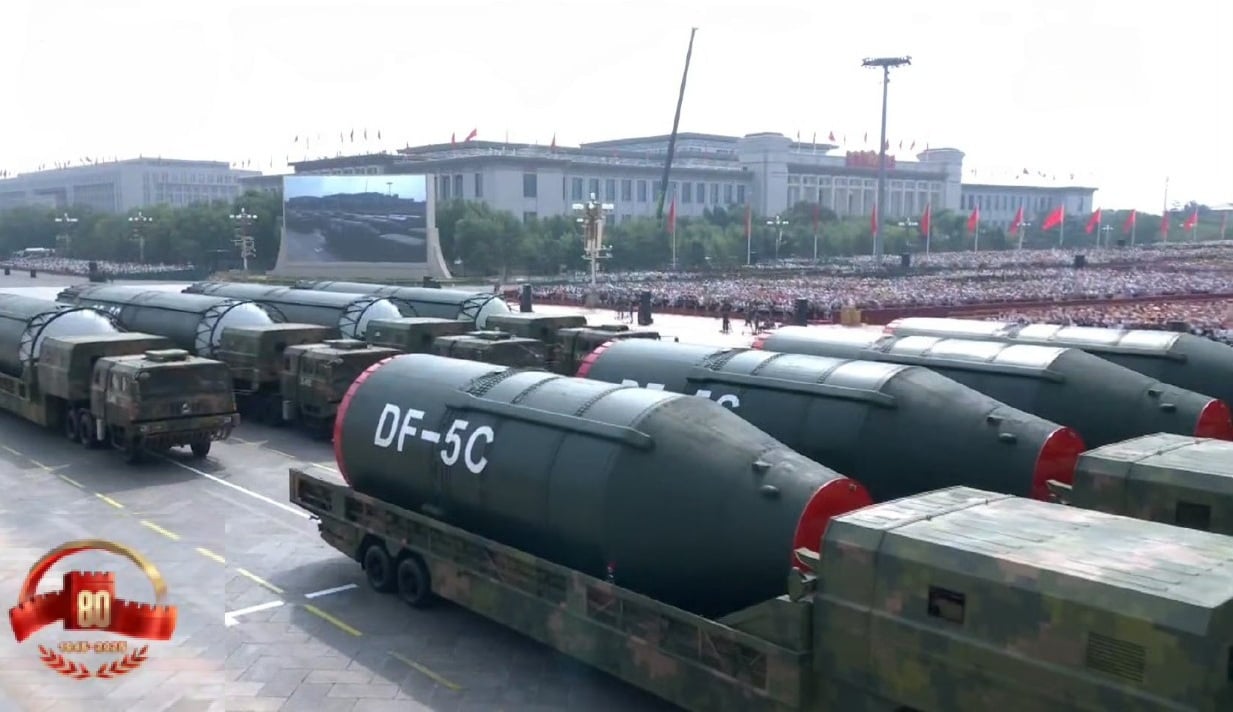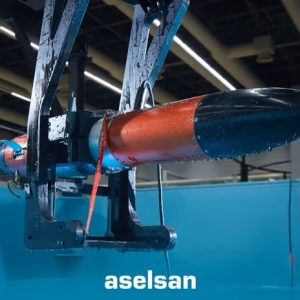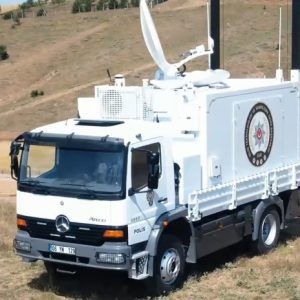China has formally introduced the DF‑5C nuclear ICBM to the public during a high‑profile military parade, presenting a silo‑based, liquid‑fueled intercontinental system that Chinese outlets describe as capable of “global‑covering” strikes. The debut places the DF‑5 family—long a pillar of Beijing’s strategic arsenal—back at the center of nuclear signaling, even as newer solid‑fuel missiles expand the force. [1][2][3]
Key Facts
• Platform & basing: Silo‑based, two‑stage, liquid‑fuel ICBM—successor within the DF‑5 series. [4][5]
• Range claims: Chinese state media describe “global coverage,” with some reports citing ~20,000 km. Western outlets typically list ~12,400 miles (20,000 km) or unspecified “global reach.” [1][2][7]
• Payload & MIRV: The DF‑5B variant carries up to five MIRVs per U.S. DoD. DF‑5C is presented as MIRV‑capable; precise loadout remains unconfirmed. [4][6]
• Warhead yield: Earlier DF‑5 warheads reported up to ~4 Mt in Chinese media coverage; not independently verified for DF‑5C. [10]
• Force structure: DoD (2024) assessed new DF‑5‑class silos and a fielding path for DF‑5C alongside expanding solid‑fuel ICBM silo fields. [4]
Why the DF‑5C matters now
The DF‑5C nuclear ICBM arrives at a moment when China is scaling its strategic forces and emphasizing a complete nuclear triad. The parade showcased air‑, sea‑, and land‑based nuclear delivery systems together, a signal intended for multiple audiences—from the United States and its allies to regional competitors and undecided observers. [1][3]
Beijing’s public presentation of DF‑5C serves several purposes. Domestically, it underlines deterrence credibility; internationally, it telegraphs survivable second‑strike potential through diversified basing and new silos; and operationally, it suggests continued investment in both liquid‑ and solid‑fuel ICBM families. The DF‑5C nuclear ICBM therefore complements, rather than replaces, newer road‑ and rail‑mobile systems. [4][5]
What’s known—and what isn’t
Open sources agree on the DF‑5 lineage: a large, two‑stage, liquid‑propellant ICBM introduced in the 1980s, modernized over time from a single high‑yield warhead to MIRV capability on the DF‑5B. CSIS and U.S. government reporting provide the best‑vetted baselines. [5][6] Beyond that, the DF‑5C’s exact performance and payload remain opaque.
Range. Chinese‑affiliated media and commentary describe “global coverage,” with specific figures around 20,000 km appearing in some reporting and graphics tied to the parade. Major Western outlets covering the event echoed a “global reach” characterization without independent technical confirmation. [1][2][7]
Payload and MIRV count. The U.S. Department of Defense has previously assessed DF‑5B at up to five multiple independently targetable reentry vehicles (MIRVs); DF‑5C is widely reported as MIRV‑capable, but neither Washington nor Beijing has published verifiable MIRV counts. Claims of six or more warheads should be treated as unconfirmed absent documentary evidence. [4][6][8]
Warhead yield. Chinese state‑media coverage referenced by Hong Kong–based outlets has credited earlier DF‑5 payloads with single warheads up to approximately four megatons—“~200× Hiroshima.” That figure describes legacy single‑RV configurations rather than today’s MIRV bus, and it is not independently corroborated for DF‑5C. [10]
Propulsion. Unverified commentary around the parade suggested staged‑combustion cycle upgrades. Such claims are difficult to validate from imagery and have not appeared in authoritative Western assessments. Given that the DF‑5C nuclear ICBM remains a storable‑liquid design, any propulsion change would aim at reliability/readiness rather than raw thrust. Treat as provisional. [8]

Strategic implications
Readiness vs. survivability. Liquid ICBMs traditionally require pre‑launch operations (e.g., fueling) that elongate timelines compared with solid systems. However, China’s construction of additional DF‑5‑class silos—and a broader silo buildout for solid‑fuel types—complicates adversary targeting and raises questions about peacetime alert levels. If even a portion of the DF‑5C nuclear ICBM fleet sits in higher states of readiness, launch‑on‑warning postures could become more credible. [4][5][6]
Penetration and burden‑sharing. A MIRV‑capable DF‑5C increases the number of aim points an adversary must defend and can pair real warheads with decoys or penetration aids. For U.S. and allied missile defenses—already sized primarily for limited threats—denial becomes harder as China fields more modern reentry vehicles and countermeasures across multiple ICBM families. [4][6]
Escalation signaling. The parade’s choreography—featuring the DF‑5C alongside new hypersonic and anti‑ship systems—reinforces a stratagem aimed at deterring intervention in East Asia. Publicly staging a legacy‑line but upgraded DF‑5C nuclear ICBM sends a deliberate message: even older basing modes, refreshed and multiplied, remain central to China’s nuclear deterrent. [1][3]
Technical context: DF‑5 lineage, DF‑5C evolution
The DF‑5 began as a single‑warhead, multi‑megaton system with an estimated range exceeding 13,000 km. Subsequent variants modernized guidance and introduced MIRV buses (DF‑5B). The DF‑5C nuclear ICBM is assessed by the Pentagon as a new, silo‑based follow‑on within this family, part of a wider expansion that includes at least dozens of additional DF‑5‑class silos alongside 300+ silos for solid ICBMs. [4][5][6]
From a force‑planning perspective, DF‑5C likely trades some operational convenience for payload flexibility and bus volume. Its large throw‑weight can host combinations of MIRVs, decoys, and penetration aids—useful against hardened targets and layered missile defenses. In practice, exact loadouts would be scenario‑dependent, and China’s opacity complicates outside modeling. [4][6]
What to watch next
Imagery cadence. Expect additional commercial‑satellite reporting on new silo construction, training activity at silo fields, and possible cable‑trench work indicative of alerting systems. [4]
Official doctrine signals. Any shift in public discussion of peacetime alert levels, launch‑on‑warning, or negative security assurances will matter as much as the hardware. [4][6]
Arms‑control implications. The expansion of China’s ICBM force—liquid and solid—complicates future numerical caps or verification regimes. Transparency around the DF‑5C nuclear ICBM would help, but Beijing historically treats such data as highly sensitive. [3][4][6]
For context on other systems unveiled at the same parade, see our analysis of the new long‑range hypersonic cruise missile: CJ‑1000 first public display.
External link
Backgrounder on the DF‑5 series from a trusted source: CSIS Missile Threat: DF‑5. [5]
Analyst note: Much of the granular performance chatter (e.g., specific MIRV counts; engine cycle upgrades) is circulating in state‑linked media or enthusiast forums. Where not supported by official U.S. or allied assessments, such details are cited here as claims, not settled facts. Readers should weigh them accordingly. [7][8][10]
Further Reading
Reuters: China’s parade of new weaponry sends message of deterrence. [1]
AP: China’s military parade reveals new hypersonic missiles, drone submarines and ICBMs. [3]
Washington Post: See China’s new missiles, tanks and drones. [2]
U.S. DoD China Military Power Report (2024). [4]
FAS: China’s silo fields and DF‑5 force posture. [9]
References
- Reuters, “China’s parade of new weaponry sends message of deterrence,” 3 Sep 2025. [Link in Further Reading]
- Washington Post interactive, “See China’s new missiles, tanks and drones,” 3 Sep 2025. [Link in Further Reading]
- AP, “China’s military parade reveals new hypersonic missiles, drone submarines and ICBMs,” 3 Sep 2025. [Link in Further Reading]
- U.S. Department of Defense, Military and Security Developments Involving the PRC 2024, DF‑5C references to new silos and fielding. [Link in Further Reading]
- CSIS Missile Threat, “DF‑5 (CSS‑4),” backgrounder. [External link above]
- Bulletin of the Atomic Scientists/FAS authors, “Chinese nuclear weapons, 2024–2025” notes on DF‑5B MIRVs. FAS 2024; Bulletin 2025.
- Global Times, “DF‑5C global‑covering strategic nuclear missile,” 3 Sep 2025 (state media claims). Link.
- Defence Blog, “China parades DF‑5C with nuclear warheads and worldwide range,” 3 Sep 2025 (imagery and parade narration). Link.
- Federation of American Scientists, “China is Building a Second Nuclear Missile Silo Field,” 26 Jul 2021 (context on silos and survivability). [Link in Further Reading]
- South China Morning Post, “Chinese state media releases key details about DF‑5 nuclear weapons,” 4 Jun 2025 (yield claim for earlier DF‑5 configurations). Link.











